How to Obtain Other Valid Generalized Modal Syllogisms from the Syllogism ▯EF◊O-1
DOI: 10.54647/computer520351 86 Downloads 168359 Views
Author(s)
Abstract
For the sake of obtaining valid generalized modal syllogisms, the article first proves the validity of the generalized modal syllogism ▯EF◊O-1 by means of set theory and modal logic, and then deduces the other 22 valid generalized modal syllogisms from the syllogism ▯EF◊O-1 in accordance with modern modal logic, generalized quantifier theory, and so on. The reason why there are reducibilities between different generalized modal syllogisms is that: (1) any of the Aristotelian quantifiers is definable by the other three Aristotelian quantifiers; (2) any of the four generalized quantifiers mentioned in this article is definable by the other three generalized quantifiers; (3) the transformation relationship between necessity and possibility; (4) the symmetry of some and no. The article presents a formal research method for generalized modal syllogistic, which not only provides a unified mathematical research paradigm for other generalized modal syllogisms and even other kinds of syllogisms, but also meet with the demands for formalization transformation of modern logic in the era of artificial intelligence. Therefore, this study has considerable theoretical and practical values.
Keywords
Generalized Modal Syllogism, Reducibility, Validity, Generalized Quantifier
Cite this paper
Jing Xu, Xiaojun Zhang,
How to Obtain Other Valid Generalized Modal Syllogisms from the Syllogism ▯EF◊O-1
, SCIREA Journal of Computer.
Volume 8, Issue 2, April 2023 | PP. 63-73.
10.54647/computer520351
References
| [ 1 ] | Xiaojun Z. (2020). Research on Extended Syllogism for Natural Language Information Processing, Beijing: Science Press. (in Chinese) |
| [ 2 ] | Jing X, Xiaojun Z.(2023a). How to Obtain Valid Generalized Modal Syllogisms from Valid Generalized Syllogisms, Applied Science and Innovative Research, 7(2): 45-51. |
| [ 3 ] | Jing X, Xiaojun Z.(2023b). The Reducibility of Generalized Modal Syllogisms Based on ▯AM◊I-1, SCIREA Journal of Philosophy, 3(1):1-11. |
| [ 4 ] | Westerståhl D. (2007). Quantifiers in formal and natural languages. Gabbay D. M. and Guenthner F.(eds.), Handbook of Philosophical Logic, Dordrecht: Kluwer Academic Publishers, 14: 223-338. |
| [ 5 ] | Xiaojun Z., Sheng L.(2016). Research on the formalization and axiomatization of traditional syllogisms, Journal of Hubei University (Philosophy and Social Sciences), 6: 32-37. (in Chinese) |
| [ 6 ] | Xiaojun Z. (2022). How to Deduce the Remaining 23 Valid Syllogisms from the AAA-1 syllogism, Journal of Guizhou University of Engineering Science, (1): 48-53. (in Chinese) |
| [ 7 ] | Xiaojun Z., Long W., Yijiang H. (2022). Reduction between the Syllogism OAO-3 and the Remaining 23 Valid Syllogisms[J]. SCIREA Journal of Computer, 7(4): 75-84. |
| [ 8 ] | Hui, L. (2023). Reduction between categorical syllogisms based on the syllogism EIO-2, Applied Science and Innovative Research, 7: 30-37. |
| [ 9 ] | Cheng, Z. (2023). How to Deduce the Other 91 Valid Aristotelian Modal Syllogisms from the Syllogism ▯I▯A▯I-3, Applied Science and Innovative Research, 7(1): 46-57. |
| [ 10 ] | Halmos P. R. (1974). Naive Set Theory, New York: Springer-Verlag. |
| [ 11 ] | Peters, S. and Westerståhl, D. (2006). Quantifiers in Language and Logic, Claredon Press, Oxford. |
| [ 12 ] | Xiaojun Z. (2014). A Study of Generalized Quantifier Theory, Xiamen: Xiamen University Press. (in Chinese) |
| [ 13 ] | Chellas, F. (1980). Modal Logic: an Introduction, Cambridge: Cambridge University Press. |
| [ 14 ] | Cheng, Z. (2022). The Remaining 23 Valid Aristotelian Syllogisms can be Deduced only from the Syllogism IAI-3, SCIREA Journal of Computer, 7(5): 85-95. |
| [ 15 ] | Chagrov, F. and Zakharyaschev, M. (1997). Modal Logic, Oxford: Clarendon Press. |
| [ 16 ] | Endrullis J., Moss L. S.( 2015). Syllogistic logic with ‘most’. V. de Paiva et al. (eds. ). Logic, Language, Information, and Computation, 124-139. |

